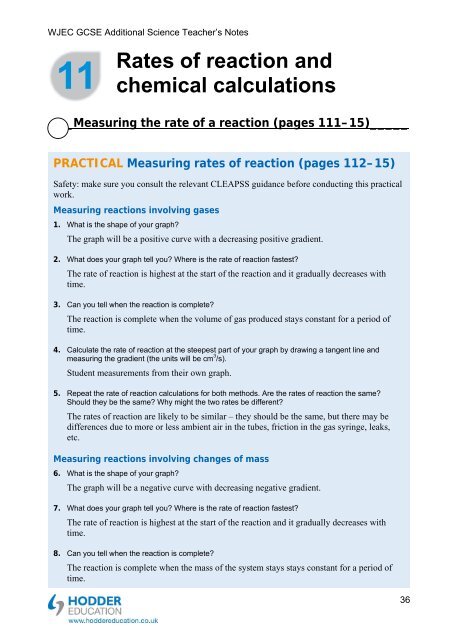Teacher's notes and answers to questions in the book - Hodder Plus ...
Teacher's notes and answers to questions in the book - Hodder Plus ...
Teacher's notes and answers to questions in the book - Hodder Plus ...
Create successful ePaper yourself
Turn your PDF publications into a flip-book with our unique Google optimized e-Paper software.
WJEC GCSE Additional Science Teacher’s Notes<br />
11<br />
Rates of reaction <strong>and</strong><br />
chemical calculations<br />
_Measur<strong>in</strong>g <strong>the</strong> rate of a reaction (pages 111–15)_____<br />
PRACTICAL Measur<strong>in</strong>g rates of reaction (pages 112–15)<br />
Safety: make sure you consult <strong>the</strong> relevant CLEAPSS guidance before conduct<strong>in</strong>g this practical<br />
work.<br />
Measur<strong>in</strong>g reactions <strong>in</strong>volv<strong>in</strong>g gases<br />
1. What is <strong>the</strong> shape of your graph<br />
The graph will be a positive curve with a decreas<strong>in</strong>g positive gradient.<br />
2. What does your graph tell you Where is <strong>the</strong> rate of reaction fastest<br />
The rate of reaction is highest at <strong>the</strong> start of <strong>the</strong> reaction <strong>and</strong> it gradually decreases with<br />
time.<br />
3. Can you tell when <strong>the</strong> reaction is complete<br />
The reaction is complete when <strong>the</strong> volume of gas produced stays constant for a period of<br />
time.<br />
4. Calculate <strong>the</strong> rate of reaction at <strong>the</strong> steepest part of your graph by draw<strong>in</strong>g a tangent l<strong>in</strong>e <strong>and</strong><br />
measur<strong>in</strong>g <strong>the</strong> gradient (<strong>the</strong> units will be cm 3 /s).<br />
Student measurements from <strong>the</strong>ir own graph.<br />
5. Repeat <strong>the</strong> rate of reaction calculations for both methods. Are <strong>the</strong> rates of reaction <strong>the</strong> same<br />
Should <strong>the</strong>y be <strong>the</strong> same Why might <strong>the</strong> two rates be different<br />
The rates of reaction are likely <strong>to</strong> be similar – <strong>the</strong>y should be <strong>the</strong> same, but <strong>the</strong>re may be<br />
differences due <strong>to</strong> more or less ambient air <strong>in</strong> <strong>the</strong> tubes, friction <strong>in</strong> <strong>the</strong> gas syr<strong>in</strong>ge, leaks,<br />
etc.<br />
Measur<strong>in</strong>g reactions <strong>in</strong>volv<strong>in</strong>g changes of mass<br />
6. What is <strong>the</strong> shape of your graph<br />
The graph will be a negative curve with decreas<strong>in</strong>g negative gradient.<br />
7. What does your graph tell you Where is <strong>the</strong> rate of reaction fastest<br />
The rate of reaction is highest at <strong>the</strong> start of <strong>the</strong> reaction <strong>and</strong> it gradually decreases with<br />
time.<br />
8. Can you tell when <strong>the</strong> reaction is complete<br />
The reaction is complete when <strong>the</strong> mass of <strong>the</strong> system stays stays constant for a period of<br />
time.<br />
36

















